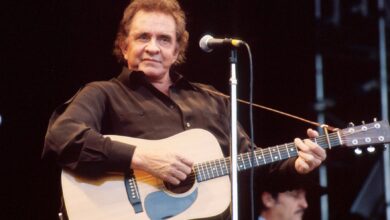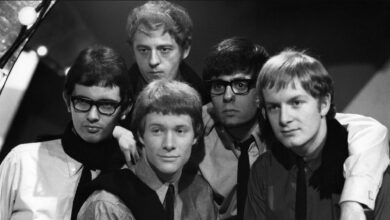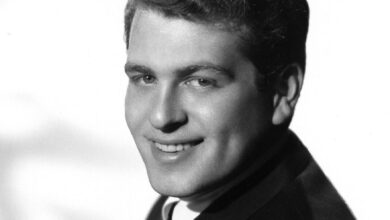Dion’s “The Wanderer” Embodies the Spirit of Early Rock ‘n’ Roll in 1961
In 1961, Dion DiMucci released “The Wanderer,” a track that would become a defining anthem of early rock ‘n’ roll. With its infectious rhythm and candid lyrics about a footloose lifestyle, the song resonated with listeners, climbing to number two on the U.S. charts and solidifying Dion’s status as a leading figure in the music scene. Its swaggering charm and bold narrative reflected the rebellious spirit of the era, cementing its place in rock history.
Born in the Bronx, New York, Dion grew up surrounded by the vibrant sounds of doo-wop harmonies and rhythm and blues. His early career with The Belmonts saw success with hits like “A Teenager in Love,” which captured the emotional highs and lows of teenage romance. Yet it was as a solo artist that Dion’s talent for storytelling truly came to the forefront. With his signature voice, infused with both grit and charisma, he effortlessly delivered songs that spoke to the restless energy of youth.
“The Wanderer” was penned by Ernie Maresca, who had previously collaborated with Dion on the chart-topping “Runaround Sue.” Inspired by the archetype of a carefree drifter, the lyrics told the story of a man who roamed from town to town, collecting fleeting romances without ever settling down. It was a bold, unapologetic character study — a sharp contrast to the more innocent themes that often dominated the charts. Dion’s commanding presence gave the character life, infusing the song with an air of confidence and independence.
The recording process was straightforward yet effective. Backed by The Del-Satins, who provided rich vocal harmonies, Dion’s performance was further elevated by a robust instrumental arrangement. The song’s signature shuffle rhythm, punctuated by Buddy Lucas’ rollicking saxophone solo, brought an undeniable energy. Every element of the track was carefully constructed to capture the free-spirited essence of its protagonist, making it instantly memorable.
Upon its release, “The Wanderer” quickly overshadowed its intended A-side, “The Majestic.” Radio DJs favored its infectious energy and relatable lyrics, propelling it up the charts. While it reached number two in the U.S., the song also gained international recognition, breaking into the top ten in the UK and Australia. Its cross-continental success demonstrated the universal appeal of its rebellious spirit.
Culturally, “The Wanderer” tapped into the growing fascination with antiheroes and self-assured protagonists. At a time when many songs idealized love and devotion, Dion’s hit stood out for its unrepentant embrace of freedom. The character’s confident bravado resonated with young listeners, reflecting the shifting attitudes of the early 1960s. As rock ‘n’ roll became a platform for self-expression, “The Wanderer” exemplified the genre’s raw, unfiltered power.
For Dion, the song’s success marked a pivotal moment. It solidified his image as a rock ‘n’ roll icon and expanded his influence beyond the doo-wop roots of his earlier career. The momentum from “The Wanderer” propelled him to new heights, leading to extensive tours and numerous television appearances. Fans gravitated toward his magnetic stage presence and authentic storytelling, further cementing his status as one of rock’s defining voices.
The song’s influence extended far beyond Dion’s career. Its bold narrative and distinctive sound left a lasting mark on rock and popular culture. Many artists, inspired by its swaggering energy, found their own voices through similar themes of rebellion and independence. “The Wanderer” also paved the way for more character-driven storytelling in rock, encouraging musicians to explore complex emotions and perspectives.
Over the decades, the song has been covered by numerous artists, each offering their own interpretation. Leif Garrett’s version in the late 1970s introduced the track to a new generation, while Status Quo’s cover in 1984 further demonstrated its enduring appeal. Each rendition paid homage to Dion’s original, while adding a fresh twist that kept the song alive in the public consciousness.
In popular media, “The Wanderer” has frequently been featured in films, television shows, and commercials, often used to evoke a sense of adventure and rebellion. Its recognizable melody and infectious rhythm have made it a go-to choice for capturing the spirit of carefree escapades. The song’s presence in cultural moments has only strengthened its legacy as a timeless classic.
Reflecting on its deeper meaning, Dion has often remarked that beneath the bravado of “The Wanderer” lies a sense of loneliness and longing. While the character exudes confidence, there’s an undeniable sense of detachment in his refusal to stay in one place. This duality is part of what makes the song so compelling — it invites listeners to both celebrate the freedom of movement and contemplate the emotional cost of a restless life.
Decades after its release, “The Wanderer” continues to enjoy regular radio play and is a staple of classic rock playlists. Recognized as one of the defining songs of its era, it remains a testament to the enduring power of rock ‘n’ roll storytelling. Its induction into numerous greatest-song lists only underscores its influence, with critics and fans alike praising its boldness and authenticity.
Ultimately, the appeal of “The Wanderer” lies in its ability to capture the thrill of independence while hinting at the deeper emotions beneath the surface. Dion’s masterful performance, paired with Maresca’s evocative lyrics, created a song that resonates across generations. As listeners continue to sing along to its iconic refrain, “The Wanderer” stands as a timeless tribute to the restless spirit of rock ‘n’ roll.



